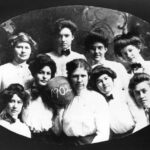Brewtopia
Thirsty UT alumni have made Austin the craft beer capital of Texas.
Can’t see the video? Click here.
Five years ago, scoring a keg of Real Ale’s Firemans #4 was a lot like a back-alley drug deal. “People whispered around corners about a keg of Firemans,” says Billy Caruso, beverage and events coordinator for Easy Tiger Bake Shop and Brew Garden. Beer enthusiasts knew about the good stuff, he says, but everyone else was too busy “drinking oak Chardonnays and oak Malbecs” to notice. Now, almost every restaurant in the city has Firemans #4 on tap.
Firemans is a benchmark of success for the craft brewing industry, which is booming in Austin. All over the city, dark porters and golden Hefeweizens are pushing wine pairings off tables at restaurants. Diners use dozens of codewords to describe what they’re looking for: bold, wheaty, hoppy, fruity, earthy, floral, clean, malty, and best of all—chocolaty. Coolers that used to be packed with Bud Light at parks and concerts are now stocked with local gems in designer cans.
Officially, according to the U.S. American Brewers Association, a craft brewery is “small, independent, and traditional,” and has a production size of fewer than 6 million barrels of beer a year. There are now 26 craft breweries in Austin—twice the number in Houston and Dallas combined. Five years ago there were only four, and Austin isn’t the only place where it’s on the rise. According to a recent New York Times article, the number of craft breweries in France recently surpassed wineries.
Leading the movement in Austin is a group of talented UT alumni—both new and seasoned—that has made the capital city the epicenter of boutique brewing in Texas. Chip McElroy, BA ’79, PhD ’89, sold his first beer with Live Oak Brewing Company in April 1997. “Everyone is into craft beer now,” McElroy says. “When we first started, you were either a Miller guy or a Bud guy, and opening a brewery just made everyone look at us funny.” Today, McElroy continues to be a huge part of the Austin beer scene. He’s even working on legislation to help Texas breweries sell their beer in other states with fewer restrictions.
Brad Farbstein, BA ’93, took over Real Ale Brewing Company in 1998, and quickly followed Live Oak’s lead. The two of them— Farbstein in Blanco and McElroy in Austin—became the heart of the movement. Until Amy and Rob Cartwright, BJ ’98 and BA ’96 respectively, founded Independence Brewing in 2004, Real Ale and Live Oak were the only local craft breweries.
 From this core group grew the vast array of craft brewers that exists today. (512) Brewing, founded and owned by Kevin Brand, BS ’96, was established in 2008, opening the floodgates for the trend that eventually swept Austin. By 2010, the number of breweries in Austin had doubled from 2008. Today, that number has quadrupled, and UT alumni are still blazing trails. Austin Beerworks was founded in 2010 by four men including Mike McGovern, MBA ’03. The company’s motto is “brewers hell-bent on excellence,” and their big hits like Pearl Snap and Peacemaker are everywhere you look.
From this core group grew the vast array of craft brewers that exists today. (512) Brewing, founded and owned by Kevin Brand, BS ’96, was established in 2008, opening the floodgates for the trend that eventually swept Austin. By 2010, the number of breweries in Austin had doubled from 2008. Today, that number has quadrupled, and UT alumni are still blazing trails. Austin Beerworks was founded in 2010 by four men including Mike McGovern, MBA ’03. The company’s motto is “brewers hell-bent on excellence,” and their big hits like Pearl Snap and Peacemaker are everywhere you look.
People come to brewing for their own reasons. Some, like McGovern, started homebrewing in college and found a way to transform it into a career. Others, like Farbstein, started off in sales for bigger, more established breweries. Amy Cartwright was just looking for a career change. Still others join in for the romance of it, even though, according to McElroy, “the industry is much harder than it looks.”
“When we first got started,” Amy Cartwright says, “everyone was asking us why we were starting a brewery. We had to reach out to guys like Real Ale for advice, and now I feel like we’re the oldest.” Earlier breweries found it more difficult to create a foundation, because businesses weren’t accustomed to selling local beers.
“Real Ale would have never got as far as it got without a lot of help from other breweries, like Live Oak, along the way,” Farbstein says. “We feel like it’s our responsibility to continue this tradition as much as we can.” Despite the competition, it’s a surprisingly friendly community. Each month, the major players in town hold a meeting where newer members of the industry get to mingle with founders. They ask questions, share trade secrets, and naturally, drink each other’s beer.
So what is it about Austin? “I think people in Austin really value supporting their own community,” Cartwright says. And she’s not alone. “Just like the food scene in Austin, there is a growing demand for alcoholic beverages to have some sort of local background,” Caruso says. “People pay more attention to the adjectives in front of the beer name, and one word they are looking for on any label is ‘Austin.’” But with the Austin market becoming saturated, some brewers arejoking about “Brewmageddon.” That’s the point when business begins to tank. Luckily, with craft beer there is even more room to create diverse, specialty products than with wine. “There are a lot of things that haven’t been done yet,” Caruso says. “The sky is the limit.”
For now at least, Brewmaggeddon seems to be a long way off. The customer base is expanding, and brewers are happily reporting that they serve their craft beers to 21-year-old college kids and 80-year-old grandmothers alike. And as a career path, it’s rather—well—refreshing. “Ultimately,” McGovern says, “if you’re having a bad day at a brewery, you’re just doing it wrong.”
Feeling thirsty? Learn more about five craft beers created by UT alumni here.
Top from left: Tim Schwartz, Erik Ogershok, and Brad Farbstein of Real Ale Brewing. Photo by Brian Birzer.
Amy and Rob Cartwright of Independence Brewing. Photo courtesy Independence Brewing.














1 Comment